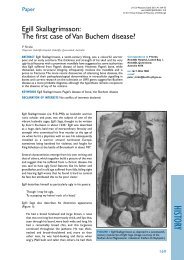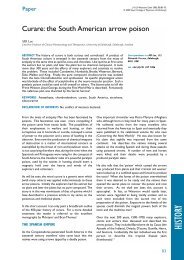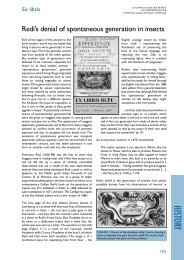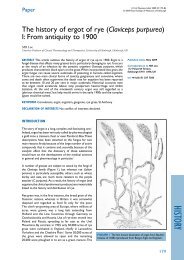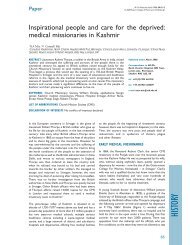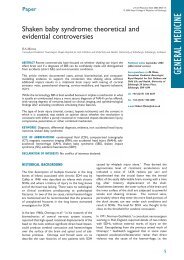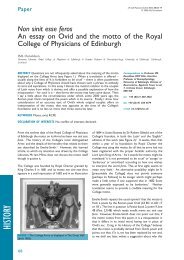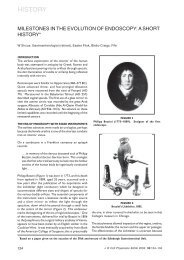The Solanaceae II: The mandrake (Mandragora officinarum); in ...
The Solanaceae II: The mandrake (Mandragora officinarum); in ...
The Solanaceae II: The mandrake (Mandragora officinarum); in ...
Create successful ePaper yourself
Turn your PDF publications into a flip-book with our unique Google optimized e-Paper software.
HISTORY<br />
MR Lee<br />
FIGURE 2 Dog Uproot<strong>in</strong>g a <strong>mandrake</strong>. Reproduced from a<br />
fourteenth century manuscript.<br />
first related to the Carthag<strong>in</strong>ian general Hannibal who,<br />
when his army was fight<strong>in</strong>g African rebels, pretended to<br />
retreat. He then left beh<strong>in</strong>d on the battlefield a number<br />
of jars of w<strong>in</strong>e which had been fortified with <strong>mandrake</strong>.<br />
<strong>The</strong> rebels drank the w<strong>in</strong>e, became sleepy, or even<br />
stuporose, and were easily defeated. It was also said that<br />
Julius Caesar, when he was captured by Sicilian pirates,<br />
employed a similar stratagem to ga<strong>in</strong> his release.<br />
THE MANDRAKE GAINS ENTRY TO BRITAIN<br />
After the fall of the Roman Empire and the so-called<br />
Dark Ages, little is heard of the <strong>mandrake</strong> <strong>in</strong> Europe (or<br />
Brita<strong>in</strong>) until the Anglo-Saxon period. 7 <strong>The</strong>n, at the end<br />
of the first millennium, Apuleius produced his famous<br />
Herbarium Platonicus and this was translated <strong>in</strong>to Anglo-<br />
Saxon. In the native language, the <strong>mandrake</strong> is described<br />
as ‘mickle’ (very) beneficial for all sorts of ailments. He<br />
notes that at night, the leaves sh<strong>in</strong>e together like a lamp,<br />
and that this signifies supernatural possession. <strong>The</strong><br />
Greek’s previous <strong>in</strong>structions <strong>in</strong> regard to harvest<strong>in</strong>g<br />
were modified <strong>in</strong> two important ways. Firstly, <strong>in</strong>stead of<br />
the man digg<strong>in</strong>g up the root(s) himself, a dog should be<br />
used to jerk it from the ground (see Figure 2). Secondly,<br />
an ivory staff should be used to loosen them (ivory was<br />
protected from evil). As with the Greeks, an iron sword<br />
was then used to cut them <strong>in</strong>to manageable portions. All<br />
this was, as far as possible, to avoid the contam<strong>in</strong>ation of<br />
the gatherer by the malign evil spirit that lived <strong>in</strong> the<br />
plant. However, if the plant was pulled from the ground<br />
at certa<strong>in</strong> holy seasons, the evil spirit would appear to<br />
the gatherer and do his bidd<strong>in</strong>g. This is very rem<strong>in</strong>iscent<br />
of the Arab belief, referred to <strong>in</strong> an earlier section, that<br />
280<br />
FIGURE 3 Bryonia Alba: the White Briony is one of the ‘false’<br />
<strong>mandrake</strong>s. From Woodville’s Medical Botany, 1794. Courtesy<br />
of the Royal College of Physicians of Ed<strong>in</strong>burgh.<br />
the plant was occupied by dj<strong>in</strong>ns (spirits) who could<br />
work for good or evil.<br />
<strong>The</strong> <strong>mandrake</strong> was not <strong>in</strong>digenous to Brita<strong>in</strong>.<br />
Consequently, its dried roots had to be imported, often at<br />
great expense. <strong>The</strong> root <strong>in</strong> its native form (or as a carved<br />
manik<strong>in</strong> or homunculus) became a prized family heirloom<br />
and was often bequeathed specifically <strong>in</strong> wills. As a result<br />
of the rarety and value of <strong>Mandragora</strong>, a search was made<br />
for native plants that could act, or <strong>in</strong>deed be passed off, as<br />
a poor man’s substitute. <strong>The</strong> plants that the medieval<br />
herbalists came up with were the black and white brionies<br />
(see Figure 3). 8 <strong>The</strong> roots of both these plants resemble<br />
those of the <strong>mandrake</strong>. <strong>The</strong>y can be carved as a<br />
homunculus and both conta<strong>in</strong> narcotic poisons. (see<br />
Figure 3). All this illustrates that between the period 1200<br />
to 1600 there was a very considerable trade <strong>in</strong> Brita<strong>in</strong><br />
(and Europe) <strong>in</strong> the <strong>mandrake</strong> and ersatz substitutes.<br />
CEREMONIES THAT SURROUND THE<br />
GATHERING OF THE MANDRAKE AND SIMILAR<br />
MAGICAL PLANTS<br />
Curious and mysterious ceremonies surround the<br />
gather<strong>in</strong>g of the <strong>mandrake</strong>. Why did the <strong>mandrake</strong><br />
generate such a love/hate relationship with the local<br />
peasants? On the one hand, they were desperate to get<br />
hold of the root because it gave them power, <strong>in</strong>fluence<br />
and <strong>in</strong>deed wealth. On the other hand, they were scared<br />
J R Coll Physicians Ed<strong>in</strong>b 2006; 36:278–285<br />
© 2006 RCPE



